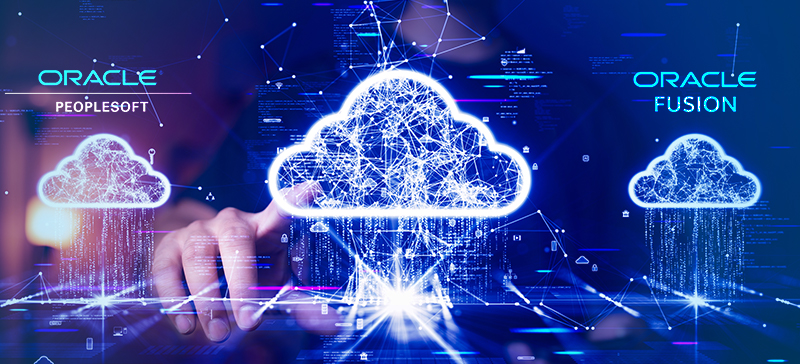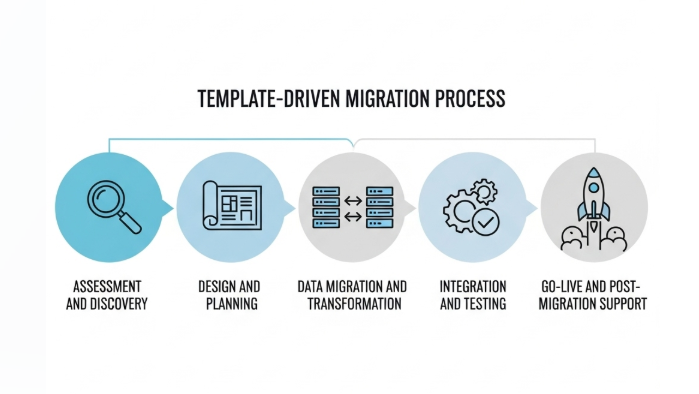
In today’s fast-paced digital landscape, enterprises are under immense pressure to modernize their core business systems to stay competitive. For many organizations, this means moving away from legacy on-premise solutions like Oracle PeopleSoft and embracing the agility, scalability, and innovation of a modern cloud platform. The Oracle PeopleSoft to Fusion Cloud Migration is a critical strategic undertaking, but it is often perceived as a daunting and resource-intensive project. Traditional migration approaches can be slow, complex, and prone to errors, leading to project delays and budget overruns.
However, a new paradigm is emerging that promises to streamline this transition: the use of pre-built migration templates. These templates, combined with automation, are fundamentally changing the game, allowing organizations to accelerate their Oracle Fusion Cloud Migration and realize the benefits of their new ERP system much faster. This blog post will delve into how pre-built templates and automation can serve as a catalyst for a successful and efficient migration, offering a step-by-step Oracle PeopleSoft to Fusion Cloud migration guide and exploring best practices for Oracle PeopleSoft to Fusion Cloud transition.
PeopleSoft has been a reliable cornerstone for many organizations for decades, but the business world has evolved. The need for real-time data, predictive analytics, and flexible, mobile-first user experiences is paramount. This is where Oracle Fusion Cloud, a comprehensive and integrated suite of applications, shines. It offers a single, unified platform for finance, human resources, supply chain, and more, all built on a modern, future-proof architecture. The benefits of this shift are clear: reduced operational costs, enhanced security, continuous innovation, and the ability to leverage emerging technologies like AI and machine learning.
The strategic importance of this move necessitates a robust PeopleSoft cloud migration strategy. Without a well-defined plan, the transition can be fraught with challenges, including data integrity issues, complex integrations, and user resistance. This is where the power of pre-built migration templates comes into play.
Think of pre-built templates as accelerators for your migration project. They are not just simple checklists; they are comprehensive, ready-to-use frameworks that encapsulate years of migration expertise. These templates are designed to address the most common challenges and complexities of moving from PeopleSoft to Oracle Fusion Cloud. They provide a standardized, repeatable approach that significantly reduces the manual effort and risk associated with the migration process.
A typical pre-built migration template includes:
By leveraging these templates, organizations can bypass the time-consuming and labor-intensive discovery and design phases of a traditional migration, moving straight into execution. This approach is central to reducing ERP migration timelines using automation and templates.
While templates provide the blueprint, automation is the engine that drives the migration forward. Automation tools, often part of an Oracle ERP cloud transition tools suite, handle repetitive tasks, such as data extraction, transformation, loading, and validation. This not only speeds up the process but also minimizes the risk of human error.
A key aspect of this is Oracle Fusion Cloud automation, which can be applied to various stages of the migration lifecycle. For example, automated tools can:
This combination of templates and automation forms the foundation of a modern PeopleSoft cloud migration strategy, enabling a seamless and efficient Data migration from PeopleSoft to Oracle Fusion.
The journey from PeopleSoft to Oracle Fusion Cloud can be broken down into several key phases, each of which is enhanced by the use of pre-built templates and automation.

Figure 1: 5 phases of template-driven migration
Before starting the migration, it's crucial to understand the current PeopleSoft environment. This involves identifying which modules are in use, analyzing customizations, and assessing data quality. A PeopleSoft retirement planning phase is essential here. The use of templates can accelerate this phase by providing a structured framework for data discovery and analysis.
This is where the pre-built templates truly shine. Instead of building a new design from scratch, you can adapt a pre-built template to your specific business requirements. This phase involves mapping PeopleSoft processes and data to the new Oracle Fusion Cloud architecture. The template provides a solid starting point, which can be configured to match the target state.
This is often the most challenging part of the migration. The use of a Metadata-driven migration approach, powered by templates, allows for the automated transformation of data. A graph illustrating the data flow could show the source PeopleSoft data, the transformation engine (powered by pre-built templates), and the target Oracle Fusion Cloud data.
A critical aspect of ERP modernization with Oracle Cloud is ensuring that the new system integrates seamlessly with other applications. The pre-built templates for PeopleSoft integration with Oracle Fusion simplify this process. Automated testing tools, guided by the templates, can then validate these integrations and ensure the integrity of the end-to-end business processes.
With a streamlined and automated process, the go-live becomes a much smoother event. Post-migration, the focus shifts to user adoption and system optimization. The pre-built templates can also serve as a foundation for ongoing system management and future enhancements.
To illustrate the practical benefits, consider a real-world example. A global manufacturing company needed to migrate from PeopleSoft to Oracle Fusion Cloud. They faced a tight deadline and a complex data landscape with over 10 years of historical data. Traditional methods would have taken more than 18 months. By adopting a solution that included Streamlined PeopleSoft migration with ChainSys pre-built workflows, they were able to dramatically reduce the project timeline.
The ChainSys solution, a perfect example of an ERP migration tools provider, utilized templates for data extraction and transformation. This allowed the company to automatically map over 80% of their data fields and run automated validation tests, ensuring high data quality. The project was completed in under 9 months, a 50% reduction in time, and with a significant cost saving. This is a testament to the power of Oracle Fusion Cloud migration with ready-to-use templates.
For a successful Enterprise cloud transformation, there are several key best practices to follow:
The ultimate goal is a successful Oracle SaaS platform adoption that positions the organization for future growth. The use of templates and automation is not just about a faster migration; it’s about a smarter, more strategic PeopleSoft migration that delivers tangible business value.
By embracing these modern approaches, organizations can turn a potentially disruptive and lengthy process into a predictable, efficient, and value-driven project, marking a new chapter in their journey with Oracle Fusion Cloud.
ChainSys’s Smart Data Platform accelerates Oracle PeopleSoft to Fusion Cloud migration using pre-built templates. This innovative approach significantly reduces the time, cost, and risks associated with complex data migration projects. The platform automates the entire process, from data extraction to loading, leveraging AI for data cleansing and validation. These pre-built templates provide a predefined structure, eliminating the need for manual data mapping and coding. The result is a faster, more reliable migration with guaranteed data quality and compliance. This allows organizations to complete their cloud transformation efficiently and with minimal disruption.
The journey from a legacy Oracle PeopleSoft environment to the dynamic Oracle Fusion Cloud is a critical step for modern enterprises. While this transition can seem daunting, the strategic adoption of pre-built migration templates and intelligent automation fundamentally changes the process. This approach not only accelerates timelines and drastically reduces manual effort but also minimizes risk and ensures data integrity. Ultimately, leveraging these tools transforms a complex PeopleSoft migration into a predictable and efficient project. The result is a successful ERP modernization with Oracle Cloud that positions your organization for continuous innovation and sustainable growth.